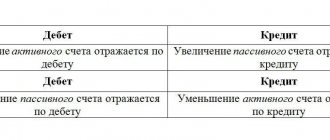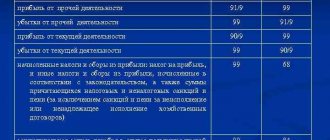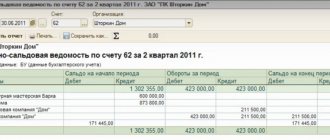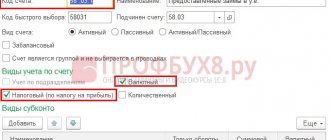Administrative and management costs are one of the main expense items of a manufacturing enterprise. To account for expenses not directly related to the production process, use account 26 - General expenses. In the article we will talk about the types of general business expenses and the features of their accounting, and also consider typical transactions and examples of reflecting account transactions.
Account 26 in accounting
Determination of general business expenses
General business expenses include all costs for administrative needs that are not directly related to production, provision of services or performance of work, but relate to the main type of activity.
The list of general business expenses depends on the profile of the organization and is not closed, according to the recommendations for using the chart of accounts.
The main general operating costs can be identified:
- Administrative and management expenses
- Business trips;
- Salaries of administration, accounting, management personnel, marketing, etc.;
- Entertainment expenses;
- Security, communication services;
- Consultations of third-party specialists (IT, auditors, etc.);
- Postal services and office.
- Repair and depreciation of non-production fixed assets;
- Rent of non-industrial premises;
- Budget payments (taxes, fines, penalties);
- Other:
Organizations not related to production (dealers, agents, etc.) collect all costs on account 26 and subsequently write them off to the sales account (account 90).
Important! Trade organizations may not use account 26, but assign all expenses to account 44 “Sales expenses”.
Main properties of account 26
Let's consider the main properties of account 26 “General business expenses”:
- Refers to active accounts, therefore, it cannot have a negative result (credit balance);
- It is a transaction account and does not appear on the balance sheet. At the end of each reporting period it must be closed (there should be no balance at the end of the month);
- Analytical accounting is carried out according to cost items (budget items), place of origin (divisions) and other characteristics.
Normative base
The use of account 26 in accounting and operations is associated with the norms of current legislation.
It is carried out in accordance with the existing chart of accounts, which was approved by Order of the Ministry of Finance of Russia No. 94 of October 31, 2000. In addition, the use of account 26 must correlate with other documents approved by law.
- At the first level there are laws of the Russian Federation and standards related to accounting and reporting approved by specialized services and structures.
- At the second level, there are various standards and government regulations that appear in accounting.
- The third level includes numerous recommendations and guidelines that are developed by the Ministry of Finance of the Russian Federation, as well as other bodies in accordance with the norms of the existing law.
- The fourth level contains work instructions, and also contains a large number of orders, order documents for recording certain operations.
- At the fifth level, the law of the Russian Federation “On Accounting and Reporting” prevails.
Typical wiring
Account 26 “General business expenses” corresponds with the following accounts:
Table 1. By debit of account 26:
| Dt | CT | Wiring Description |
| 26 | 02 | Depreciation calculation for non-production fixed assets |
| 26 | 05 | Depreciation calculation for non-production intangible assets |
| 26 | 10 | Write-off of materials, inventory, workwear for general business needs |
| 26 | 16 | Variance in the cost of written-off general business materials |
| 26 | 21 | Write-off of semi-finished products for general business purposes |
| 26 | 20 | Attribution of costs (work, services) of the main production to general economic needs |
| 26 | 23 | Attribution of costs (work, services) of auxiliary production to general economic needs |
| 26 | 29 | Attribution of costs (work, services) of service production to general economic needs |
| 26 | 43 | Write-off of finished products for general business purposes (experiments, research, analyses) |
| 26 | 50 | Decommissioning of postage stamps |
| 26 | 55 | Payment of expenses (minor work, services) from special bank accounts |
| 26 | 60 | Payment for work and services of third parties for general business needs |
| 26 | 68 | Calculation of payments of taxes, fees, penalties |
| 26 | 69 | Deduction for social needs |
| 26 | 70 | Calculation of wages for administrative, managerial and general business personnel |
| 26 | 71 | Accrual of travel expenses, as well as accountable expenses for small general business needs |
| 26 | 76 | General expenses related to other creditors |
| 26 | 79 | General business expenses associated with the organization's divisions on a separate balance sheet |
| 26 | 94 | Write-off of shortages without perpetrators, except for natural disasters |
| 26 | 96 | Assigning general business expenses to the reserve for future expenses and payments |
| 26 | 97 | Write-off of a share of future expenses for general business expenses |
Table 2. For the credit of account 26:
| Dt | CT | Wiring Description |
| 08 | 26 | Attribution of general business expenses to capital construction |
| 10 | 26 | Capitalization of returnable waste and unused materials written off as general business expenses |
| Write-off of general business expenses when closing the month, that is, where account 26 is written off | ||
| 20 | 26 | For main production |
| 21 | 26 | For the production of semi-finished products |
| 29 | 26 | For service production |
| 90.02 | 26 | Performed work and services for third parties |
| 90.08 | 26 | On the cost of sales when using the direct costing method |
***
Although direct posting Dt 26 Kt 26 is not used in practice, there are quite a few options for corresponding accounts for the general expenses account. All amounts accumulated on it must be written off at the end of the month using one of the methods established in the company’s accounting policy.
Similar articles
Closing 26 accounts
Closing account 26, that is, writing off all general business expenses, is performed in several ways:
- Included in the cost of production through production accounts if products are produced;
- Referred to as cost of sales when providing services or work;
- Referred to the current expenses of the reporting month using the direct costing method:
Important! The write-off method, as well as the basis for the distribution of general business expenses, must be fixed in the accounting policies of the organization.
Write-off as part of the cost of production
In this case, general business expenses are written off in shares, taking into account the distribution base, into production accounts and may remain on product cost accounts (for example, when producing products under account 43 “Finished Products”) or production accounts (for example, work in progress under account 20 “Main Production” ) at the end of the reporting period.
Main types of cost distribution bases:
- Revenue
- Product output volume
- Planned cost of production
- Material costs
- Direct costs
- Salary and so on
When closing the month, the following transactions are generated, for example:
| Dt | CT | Wiring Description |
| 20 | 26 | General business expenses for main production were written off |
| 23 | 26 | General business expenses for auxiliary production were written off |
General business expenses are distributed to the cost of production (production accounts) according to the specified distribution and analytical accounting base:
Therefore, general business expenses are written off:
- In full - if one product is produced (no analytics);
- Distributed across all types of products in proportion to the selected base - if several types of products are produced and calculated in the context of analytics.
Example
LLC "Horns and Hooves" produces hats and shoes, the production of which is carried out at a planned cost. In an organization, direct expenses are reflected in account 20 “Main production”, and indirect expenses in account 26 “General business expenses”.
The accounting policy states:
- General business expenses are written off against the cost of production.
- The distribution base is material costs.
In November 2021, direct expenses amounted to RUB 51,040.00:
- For headwear – RUB 28,020.00. of them:
- Material costs – RUB 15,000.00.
- For the production of shoes - RUB 23,020.00. of them:
- Material costs – RUB 10,000.00.
indirect costs – 18,020 rubles.
- 3/p administrative staff – RUB 10,000.00.
- Insurance premiums – RUB 3,020.00.
- Premises rental – RUB 5,000.00.
According to the distribution base for material costs:
Postings when closing account 26
| 30.11.2016 | 20 | 26 | 10 812 | Closing account 26 (headwear) |
| 30.11.2016 | 20 | 26 | 7 208 | Closing account 26 (shoes) |
Important! Also in the accounting policy, you can indicate non-distributable general business expenses, which will be written off immediately to current expenses in Account 90.08.
Write-off to cost of sales
If the accounting policy specifies the write-off method “to cost of sales,” then the following transactions are taken into account when closing the period:
| Dt | CT | Wiring Description |
| 90.02 | 26 | General business expenses are written off as the cost of services and work |
In this case, costs can also be taken into account in terms of analytics.
Write-off using direct costing method
If the accounting policy specifies the “direct costing” write-off method, then general business expenses are taken into account as semi-fixed and when closing the period they are reflected in the following entries:
| Dt | CT | Wiring Description |
| 90.08 | 26 | General business expenses are written off as cost of sales |
In this case, the amount of costs is written off in full in each reporting period.
Rules for issuing accountable funds
When issuing money for reporting, the accountant must be guided by the following rules:
- from 2021, in order to provide accountable funds, full repayment of debt on previously issued amounts is not required.
- if funds are transferred for a business trip, the amount is calculated according to the limits established by the company’s internal regulations.
- the basis for issuing money is a statement drawn up by the recipient employee in any form. It indicates the required amount, the needs for which it is required, and the period for its use. The finished document is signed by the director of the company. Since 2018, an application is not required; an order or directive from the manager is sufficient.
- money owed to the accountable cannot be given to a third party.
When the money is spent, the employee draws up and submits an advance report to the accounting department. Postings in 1C 8.3 are made on the basis of this document. The specialist has three days to prepare the report from the date of expiration of the period for which the amount was issued. If there are any surpluses left, they must be handed over to the company's cash desk.
To streamline work with accountable persons, the company issues an internal local act, which states:
- which employees are entitled to receive funds on account;
- for what period of time the money is issued;
- in which period the report is compiled, the surplus is returned.
Examples of using account 26 “General business expenses”
Let's look at the above wiring using examples.
Example 1. Closing an account for the cost of production at the planned cost, one type of product
LLC "Horns and Hooves" produces products, the production of which is carried out at a planned cost. In an organization, direct expenses are reflected in account 20 “Main production”, and indirect expenses in account 26 “General business expenses”.
The accounting policy states:
- General business expenses are written off against the cost of production.
- The distribution base is the planned cost.
In November 2021, direct expenses amounted to RUB 88,040:
- 3/p production employees – RUB 20,000.00.
- Insurance premiums – RUB 6,040.00.
- Material costs – RUB 62,000.00.
Indirect costs – RUB 13,020:
- 3/p administrative personnel – RUB 10,000.00;
- Insurance premiums – RUB 3,020.00:
| date | Account Dt | Kt account | Amount, rub. | Wiring Description | A document base |
| Output | |||||
| 16.11.2016 | 43 | 40 | 85 000 | Release of finished products (at planned cost) | Production report, invoice on acceptance of products to the warehouse |
| 16.11.2016 | 20 | 10 | 62 000 | Write-off of materials | Request-invoice |
| Payroll for production workers | |||||
| 30.11.2016 | 20 | 70 | 20 000 | Salary accrued | Time sheet, payslip |
| 30.11.2016 | 70 | 68 | 2 600 | Personal income tax withheld | |
| 30.11.2016 | 20 | 69 | 6 040 | Insurance premiums accrued | |
| Payroll for administrative and management personnel | |||||
| 30.11.2016 | 26 | 70 | 10 000 | Salary accrued | Time sheet, payslip |
| 30.11.2016 | 70 | 68 | 1 300 | Personal income tax withheld | |
| 30.11.2016 | 26 | 69 | 3 020 | Insurance premiums accrued | |
| Closing the month | |||||
| 30.11.2016 | 20 | 26 | 10 000 | Closing account 26 (salaries) | |
| 30.11.2016 | 20 | 26 | 3 020 | Closing account 26 (insurance premiums) | |
| 30.11.2016 | 40 | 20 | 101 060 | Write-off of the actual cost of production (26,040.00 (Labour) + 62,000.00 (Material costs) + 13,020.00 (General expenses)) | |
| 30.11.2016 | 43 | 40 | 16 060 | Adjustment of product cost to actual value | |
Important! If PBU is used, and general business expenses are taken into account in tax accounting as indirect expenses (established in the accounting policy), then temporary differences (TD) also arise:
| VR/NU | Account Dt | Kt account | Amount, rub. | Wiring Description |
| VR | 20 | 26 | 10 000 | Closing account 26 (salaries) |
| WELL | 90.08 | 26 | 10 000 | |
| VR | 90.08 | 26 | -10 000 | |
| VR | 20 | 26 | 3 020 | Closing account 26 (insurance premiums) |
| WELL | 90.08 | 26 | 3 020 | |
| VR | 90.08 | 26 | -3 020 | |
| WELL | 40 | 20 | 88 040 | Write-off of the actual cost of production |
| VR | 40 | 20 | 13 020 | |
| WELL | 43 | 40 | 3 040 | Adjustment of product cost to actual value |
| VR | 43 | 40 | 13 020 |
Example 2. Closing an account for the cost of sales when providing services
Horns and Hooves LLC provides security services. General business expenses are written off immediately to the cost of security services.
In November 2021, general business expenses amounted to RUB 23,020.
- 3/p personnel – RUB 10,000.00;
- Insurance premiums – RUB 3,020.00;
- Premises rental – RUB 10,000.00:
| date | Account Dt | Kt account | Amount, rub. | Wiring Description | A document base |
| 24.11.2016 | 26 | 60 | 10 000 | Rent accrued | The act of providing services |
| 26.11.2016 | 62 | 90.01 | 30 000 | Revenue accounting | The act of providing services |
| 90.03 | 68 | 5 400 | VAT charged | ||
| 30.11.2016 | 26 | 70 | 10 000 | Salary accrued | Time sheet, payslip |
| 30.11.2016 | 70 | 68 | 1 300 | Personal income tax withheld | |
| 30.11.2016 | 26 | 69 | 3 020 | Insurance premiums accrued | |
| Closing the month | |||||
| 30.11.2016 | 90.02 | 26 | 23 020 | Write-off of general business expenses to cost of sales posting | |
Postings for deductions from wages: Dt 70 Kt 76 (73, 68)
- The responsibility of the employer, who is an intermediary (tax agent) between the Federal Tax Service and the recipient of income (employee), is to calculate and withhold personal income tax. In this case, the entry is made: Dt 70 Kt 68.
For more information about the nuances of calculating personal income tax, see the article “Calculation of personal income tax (personal income tax): procedure and formula.”
- If a loan agreement has been entered into between the employee and the company, monthly interest and principal amounts may be deducted from his paycheck. The basis is a written statement from the employee. The accounting entry in this case will be as follows: Debit 70 Credit 73.
- Deductions for compensation for shortages of goods and materials or damage caused are reflected similarly: Dt 70 Kt 73.
- In addition, the employer is obliged to make deductions from the salary accrued to the employee according to executive documents. These may be court orders or bailiff orders, notarized agreements on the withholding of alimony, etc. Such transactions are reflected by the posting: Dt 70 Kt 76 .









